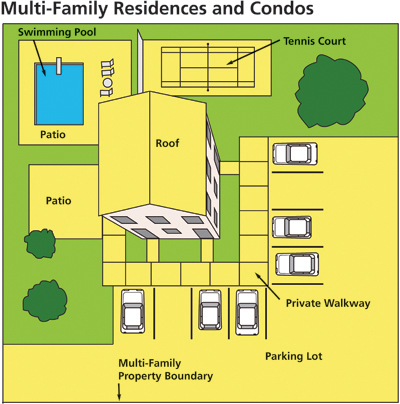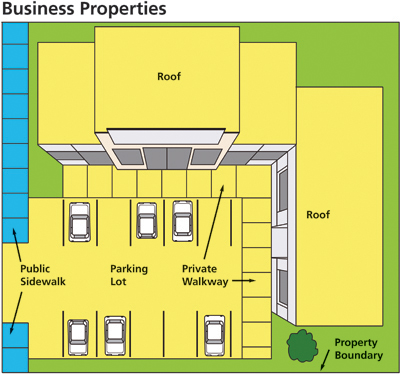Multi-Family and Non-Residential Properties
You may reduce your WQPC amount. Use the WQPC forms to
- apply for a credit
- submit an appeal
- request to combine accounts for adjoining properties
Applications, submissions, and requests are due September 30.
The WQPC is determined with this formula
Water Quality Protection Charge for a property = (Total square feet of impervious area / ERU) * Rate
See rate and impervious surface details.
See the WQPC calculation for your property. This includes the aerial image used to determine your charge.
Impervious area for multi-family properties
The total impervious area for the entire property is divided equally by the number of owners within the property boundary. For example, if there are 8 condo owners within a property, the total impervious area for the entire property is divided by 8.
The WQPC for each condo owner is their portion of the impervious surface area added to the WQPC formula.
Impervious area for non-residential properties
The impervious surface area for non-residential properties includes all buildings, parking lots, sidewalks, and any other impermeable installations permanently attached to the property containing those installations.
WQPC calculation examples
Condo in a multi-family property - Calculation example
Javier owns a condo in a multi-family residential building. There are 6 condos in the building, including Javier’s condo. The building has 4,000 square feet of building area, 2,000 square feet of parking, 2,000 square feet of patio, 500 square feet of basketball court and 200 square feet of driveway.
The total impervious surface area for the building is: 4,000 + 2,000 + 2,000 + 500 + 200= 8,700 square feet.
8,700 / 6 = 1,450 square feet of impervious space per condo owner
To calculate Javier’s charge:
WQPC = (1,450 / 2,406) * $147.00 = $88.59
Non-residential property - Calculation example
Maria owns a property with a restaurant. The restaurant has 6,000 square feet of roof surface area, 6,000 square feet of parking lot and 2,000 square feet of outdoor paved patio.
The total impervious surface area for Maria's property is: 6,000 + 6,000 + 2,000 = 14,000 square feet
To calculate Maria's charge:
WQPC = (14,000 / 2,406) X $147.00 = $855.36
Semi-detached non-residential property - Calculation example
If your non-residential property is part of a larger building with multiple property owners, such as a storefront in a mixed-use building, the calculation is slightly different.
To calculate the charge for semi-detached non-residential properties:
- Divide the total shared impervious surface area by the number of property owners
- To the number from Step 1, add the total impervious space area solely within the boundaries of your property
- Use the result from Step 2 as your total square feet of impervious area
Example
Kaleb owns a toy store in a strip of 5 connected commercial properties. The roof surface area for all the businesses is 20,000 square feet. The shared parking lot is 8,000 square feet.
The total impervious surface area for the strip of businesses is 20,000 + 8,000 = 28,000 square feet.
Because Kaleb is one of 5 properties in the strip, he is responsible for 1/5 of the total surface area: 28,000/5 = 5,600 square feet per property owner.
To calculate Kaleb’s charge:
WQPC = (5,600 / 2,406) X $147 = $342.14
Property examples


You may reduce your charge
Stormwater Management Credit
Account information you need for your credit application
County regulations require property owners to renew the WQPC credit every 3 years.
- Account ID as it appears on the property tax bill (8 digit number)
- Check if this is a “new” or a “renewal” application.
- Owner Name as it appears on your property tax bill.
- Property Address, City, State, and Zip Code of the physical location of the property with an on-site Stormwater Management System.
- Mailing Address, City, State, and Zip Code if different than site address. This is needed to send correspondence regarding credit application.
- Telephone Number to contact property owner regarding credit application and coordination of site visit.
- E-mail address to provide to contact property owner regarding credit application (include renewal reminder) and coordination of site visit.
Applicant can directly input the design volume into the NR/MFR Credit Calculator if design plans or other design data are available. If no design data are available for the stormwater management system’s treatment volume, the NR/MFR Credit Calculator will automatically calculate an Assumed Treatment Volume based on the practice’s design era and contributing drainage area. For more information, call 3-1-1 or submit a service request.
Engineer certified plans to include are:
- Total Impervious Area (square). This includes buildings, parking lots, walkways, driveways, sheds. Section 19-21 of the County Code defines Impervious Area as “[a]ny surface that prevents or significantly impedes the infiltration of water into the underlying soil, including any structure, building, patio, sidewalk, compacted gravel, pavement, asphalt, concrete, stone, brick, tile, swimming pool, or artificial turf.”
- Year of Installation (required for determining Facility Credit Percentage).
- Facility Size and Units (required by DEP to evaluate facility and treatment of impervious area). For example, rain garden size may be listed as number of square feet.
- Impervious Area Treated by Stormwater Management System (required for calculating the credit). Include photograph of Stormwater Management System (required by DEP to evaluate practices and treatment of impervious area).
See the Water Quality Protection Charge Credit Procedures Manual (PDF).
Multi-family residential and nonresidential property owners can participate in the WQPC Credit Program and receive a reduction of
- up to 60%, based on the volume of water treated by a combination of environmental site design and other stormwater management systems, or
- up to 80%, based on the volume of water treated, if the property is completely treated by environmental site design practices.
Additional credits can be achieved for offsite stormwater treatment.
The credit is based on the volume of water captured.
Stormwater management practices can be installed on the grounds, and reduce the charge for each property owner in the condominium regime.
Stormwater management practices are landscaping techniques or structures that help reduce stormwater runoff, prevent stream damage and flooding and erosion. Some practices even beautify your property!
Types of stormwater management practices eligible for credit include:
Do you have a stormwater management practice on your property?
Yes, my practice is registered with the County!
You can apply for a credit. A credit is a reduction off your annual WQPC.
A condominium regime (condo association) only needs to complete one application. If the stormwater practice applies to all property owners within the condominium, you must include a list of tax accounts qualified for the credit.
The property owner must maintain stormwater management practices in accordance with the maintenance requirements of the Department of Environmental Protection (DEP).
No, but I want to.
The RainScapes program works with property owners to install stormwater management practices like rain gardens, conservation landscaping and green roofs. You could even receive financial incentives!
I'm not sure.
Your property may have practices that were installed by a previous owner or during construction. If you have a garden on your property, it might be a RainScape.
Search your address to see if you already have a practice registered with the County.
Search our map to see if your property has stormwater management facilities registered with the County.
Appeals and Contiguous Single Owner Properties
Information you need for your appeal
When appealing, the property owner must provide:
- A detailed statement of the basis for the petition, and
- Documents supporting
- the assertion that the property should be assigned a different classification; or
- that the impervious area measurements used to calculate the equivalent residential units for the property are incorrect; or
- that the property is not subject the WQPC under the applicable law.
Appeals
If a property owner believes that the WQPC was assigned or calculated incorrectly, they may petition the Director of the Department of Environmental Protection for an adjustment by submitting a written request, using the appeal form.
Within 60 days after receiving the appeal petition, the Director will
- review the WQPC assigned to the property and
- make a written determination of whether the property owner's request for an adjustment of the charge should be granted or denied.
Requests to combine adjoining properties
Property owners can apply for combining contiguous single-owner property accounts into one. Contiguous properties have no separation, such as a road, between properties.
If the property spans multiple tax accounts, you can appeal to have the separate accounts combined into one for the purposes of calculating the WQPC.
Petition the Director of the Department of Environmental Protection for an adjustment by submitting a written request, using the online appeals form.